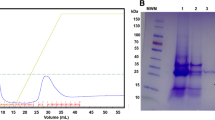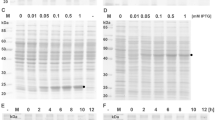Summary
We amplified the human T-cell leukemia virus type 1 (HTLV-1) protease gene fragment by polymerase chain reaction (PCR) and cloned it into a pUC plasmid vector. DNA sequencing data of the protease gene fragment indicated that it contained an open reading frame capable of encoding the active HTLV-1 protease. To express a fusion protein of β-galactosidase linked with the HTLV-1 protease inEscherichia coli, a plasmid DNA was constructed by inserting the HTLV-1 protease gene DNA into a procaryotic expression vector, pUEX2, consisting of alacZ gene directed by a λ phage Pr promoter and designated pUEX-pro. By Western blot analysis using anti-β-galactosidase antibody, a bigger molecular size band than that of the control β-galactosidase molecule was observed inE. coli cells transformed with pUEX-pro but not with control pUEX 2, suggesting that the particular fusion protein was successfully expressed. This recombinant protease protein in theE. coli cell lysate was demonstrated to be able to cleave the decapeptide substrates composed of amino acid sequences containing proteolytic cleavage sites in the HTLV-1gag precursor polyprotein. Thegag precursor polyprotein expressed in the mammalian cells by the recombinant vaccinia virus system was also expectedly cleaved by this enzyme. Significant inhibition of this protease activity by pepstatin A, an aspartic proteinase-specific inhibitor, confirms that HTLV-1 protease is a member of the aspartic proteinase group as suggested previously. Since the crude lysate without purification is utilized sufficiently as a native HTLV-1 protease reagent, this protease preparation is easily applicable to the large scale screening of HTLV-1 protease inhibitors for the treatment of diseases caused by HTLV-1.
Similar content being viewed by others
References
Brinkworth RI, Woon TC, Fairlie DP (1991) Inhibition of HIV-1 proteinase by non-peptide carbosylates. Biochem Biophys Res Commun 176: 241–246
Copeland TD, Oroszlan VS, Kalyanaraman VS, Sarngadharan MG, Gallo RC (1983) Complete amino acid sequence of human T-cell leukemia virus structural protein p 15. FEBS Lett 162: 390–395
Dunn BM, Kay J (1990) MiniReview: antiviral targets series, number 1. Targets for antiviral chemotherapy: HIV-proteinase. Antiviral Chem Chemother 1: 3–8
Erickson J, Neidhart DJ, VanDrie J, Kempf DJ, Wang XC, Norbeck DW, Plattner JJ, Rittenhouse JW, Turon M, Wideburg N, Kohlbrenner WE, Simmer R, Helfrich R, Paul DA, Knigge M (1990) Design, activity, and 2.8 Å crystal structure of a C2 symmetric inhibitor complexed to HIV-1 protease. Science 249: 527–532
Gessain A, Barin F, Vernant JC, Gout O, Maurs L, Calender A, deThe G (1985) Antibodies to human T lymphotrophic virus type-I in patients with tropical spastic paraparesis. Lancet ii: 407–410
Hatfield D, Feng Y-X, Lee BJ, Rein A, Levin JG, Oroszlan S (1989) Chromatographic analysis of the aminoacyl-tRNAs which are required for translation of codons at and around the ribosomal frameshift sites of HIV, HTLV-1, and BLV. Virology 173: 736–742
Hayakawa T, Misumi Y, Kobayashi M, Ohi Y, Fujisawa Y, Kakinuma A, Hatanaka M (1991) Expression of human T-cell leukemia virus type I protease inEscherichia coli. Biochem Biophys Res Commun 181: 1281–1287
Hinuma Y, Nagata K, Hanoaka M, Nakai M, Matsumoto T, Kinoshita K, Shirakawa S, Miyoshi I (1981) Adult T-cell leukemia: antigen in an ATL cell line and detection of antibodies to the antigen in human sera. Proc Natl Acad Sci USA 78: 6476–6480
Hiramatsu K, Nishida J, Naito A, Yoshikura H (1987) Molecular cloning of the closed circular provirus of human T cell leukaemia virus type I: a new open reading frame in thegag-pol region. J Gen Virol 68: 213–218
Katoh I, Yoshinaka A, Rein A, Shibuya M, Okada T, Oroszlan S (1985) Murine leukemia virus maturation: protease region required for conversion from “immature” to “mature” core form and for virus infectivity. Virology 145: 280–292
Katoh I, Yasunaga T, Ikawa Y, Yoshinaka Y (1987) Inhibition of retroviral protease activity by an aspartyl proteinase inhibitor. Nature 329: 654–656
Katoh I, Ikawa Y, Yoshinaka Y (1989) Retrovirus protease characterized as a dimeric aspartic proteinase. J Virol 63: 2226–2232
Katoh I, Yoshinaka Y (1990) Retroviral protease: a newly identified aspartyl proteinase. Exp Med 8: 59–62 (in Japanese)
Kobayashi M, Ohi Y, Asano T, Hayakawa T, Kato K, Kakinuma A, Hatanaka M (1991) Purification and characterization of human T-cell leukemia virus type I produced inEscherichia coli. FEBS Lett 293: 106–110
Laemmli UK (1970) Cleavage of structural proteins during the assembly of the head of bacteriophage T4. Nature 227: 680–685
McQuade TJ, Tomasselli AG, Liu L, Karacostas V, Moss B, Sawyer TK, Heinrikson RL, Tarplay WG (1990) A synthetic HIV-1 protease inhibitor with antiviral activity arrests HIV-like particle maturation. Science 247: 454–456
Miller M, Schneider J, Sathyanarayana BK, Toth MV, Marshall GR, Clawson L, Selk L, Kent SB, Wlodawer A (1989) Structure of complex of synthetic HIV-1 protease with a substrate-based inhibitor at 2.3 Å resolution. Science 246: 1149–1152
Nam SH, Hatanaka M (1986) Identification of a protease gene of human T-cell leukemia virus type I (HTLV-I) and its structural comparison. Biochem Biophys Res Commun 139: 129–135
Nam SH, Kidokoro M, Shida H, Hatanaka M (1988) Processing ofgag precursor polyprotein of human T-cell leukemia virus type I by virus-encoded protease. J Virol 62: 3718–3728
Navia MA, Fizgerrald PMD, McKeever BM, Leu C-T, Heimbach JC, Herber WK, Sigal IS, Darke PL, Springer PS (1989) Three-dimensional structure of aspartyl protease from human immunodeficiency virus HIV-1. Nature 337: 615–620
Oroszlan S, Sarugadharan MG, Copeland TD, Kalyanaraman VS, Gihden RV, Gallo RC (1982) Primary structure analysis of the major internal protein p 24 of human type C T-cell leukemia virus. Proc Natl Acad Sci USA 79: 1291–1294
Osame M, Usuku K, Izumo S, Ijichi N, Amitani H, Igata A, Matsumoto M, Tara M (1986) HTLV-1 associated myelopathy, a new clinical entity. Lancet i: 1031–1032
Riviere Y, Blank V, Kourilsky P, Israel A (1991) Processing of the precursor of NF-kB by the HIV-1 protease during acute infection. Nature 350: 625–626
Sanger F, Nicklen S, Coulsen AR (1977) DNA sequencing with chain-termination inhibitors. Proc Natl Acad Sci USA 74: 5463–5467
Seiki M, Hattori S, Hirayama Y, Yoshida M (1983) Human adult T-cell leukemia virus: complete nucleotide sequence of the provirus genome integrated in leukemia cell DNA. Proc Natl Acad Sci USA 80: 3618–3622
Sugamura K, Fujii M, Kannagi M, Sakitani M, Takeuchi M, Hinuma Y (1984) Cell surface phenotypes and expression of viral antigens of various human cell lines carrying human T-cell leukemia virus. Int J Cancer 34: 221–228
Tanaka Y, Koyanagi Y, Chosa T, Yamamoto N, Hinuma Y (1983) Monoclonal antibody reactive with both p 28 and p 19 of adult T-cell leukemia virus specific polypeptides. Gann 74: 327–330
Tomasselli AG, Olsen MK, Hui JO, Staples DJ, Sayer TK, Heinrikson RL, Tomich CC (1990) Substrate analogue inhibition and active site titration of purified recombinant HIV-1 protease. Biochemistry 29: 264–269
vonder Helm K (1977) Cleavage of Rous sarcoma viral polypeptide precursor into internal structural proteins in vitro involves viral protein p 15. Proc Natl Acad Sci USA 74: 911–915
Wlodawer A, Miller M, Jaskolski M, Sathyanaratakaya BK, Baldwin E, Weber IT, Selk LM, Clawson L, Schneider J, Kent SBH (1989) Conserved folding in retroviral proteases: crystal structure of a synthetic HIV-1 protease. Science 245: 616–621
Yoshida M, Miyoshi I, Hinuma Y (1982) Isolation and characterization of retrovirus from cell lines of human adult T-cell leukemia and its implication in the disease. Proc Natl Acad Sci USA 79: 2031–2035
Zabin I (1982) β-galactosidase α-complementation. A model of protein-protein interaction. Mol Cell Biochem 49: 87–96
Author information
Authors and Affiliations
Rights and permissions
About this article
Cite this article
Saiga, A., Tanaka, T., Orita, S. et al. Human T-cell leukemia virus type 1 protease protein expressed inEscherichia coli possesses aspartic proteinase activity. Archives of Virology 128, 195–210 (1993). https://doi.org/10.1007/BF01309434
Received:
Accepted:
Issue Date:
DOI: https://doi.org/10.1007/BF01309434




